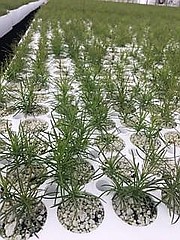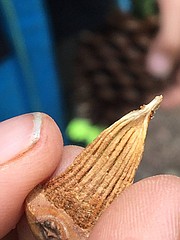Groups band together to help reforest Sunrise burn area
Looking over the terrain of Sunrise Mountain swaths of black tree stands are a stark reminder of the wildfire that ravaged the area last summer. The fire chewed through 27,000 acres which was primarily Lolo National Forest Land. The area is a mix of conifer forest on steep mountainous terrain and affected a number of drainages including Trout, Cougar, Verde, Sunrise, Meadow, and Quartz Creeks.
In all, approximately 4,600 acres of trees were burned with such high severity that they are dead and will not recover. Even trees in lower severity areas which still appear green, had roots scorched so badly by the heat that they will also die.
Unfortunately, much of the U.S. Forest Service budget is spent on fighting massive wildfires that plague the country every year and not much is left for replanting forest land. If these areas are not replanted within a reasonable time after a fire, insect infestation, disease and weather can take a toll on the land. Including invasive species of trees and brush that are fire-prone could take over, wildlife will not have critical habitat and watershed areas will no longer be able to provide clean water.
In the case of the Sunrise Fire, an environmental assessment released in May found there were few live seed sources left for natural regeneration. As a result, there is a need for planting native tree seedling on approximately 7,200 acres of forest service land, including ponderosa pine, western white pine, and western larch. The remaining 17,600 acres will not be planted and natural regeneration will occur.
Knowing the dire need for replanting, a group of concerned citizens in Alberton decided to step up and do something about the situation. Last November, the Alberton Railroad Days Foundation set out to raise funds to purchase 30,000 trees, enough to reforest nearly 300 acres.
By the end of their drive, they had raised nearly $11,000 to purchase 32,000 trees. This was done by getting over $5,000 in donations with a match by the National Forest Foundation. But replanting takes time and patients. Seeds are meticulously extracted from pinecones native to the area and then are grown for two years before they can be planted.
“During those two years, we don’t want the community to lose interest in the project and so we are going to continue to participate in activities which involve the trees,” said foundation board member, Sheri Bayer.
Part of that community involvement is partnering with the Alberton Afterschool and Summer Programs. Last week nearly a dozen third through sixth graders spent time with Ninemile District Rangers learning about trees, wildfires, and replanting.
“It was empowering for the kids to connect with nature this way. They were able to see the process of collecting seeds, and planting them,” said Alberton Afterschool coordinator, Jesse Maurer.
Ninemile Ranger Carly Annaballe guided the kids through various activities, including boring a sample out of a tree. A corkscrew device called an increment borer, pulls a section out without damaging the tree and they can learn about the growth and health of it. In the rings of an 800 year-old tree, the group saw that there were distinct black rings which showed when fires occurred.
“Carly was able to count the rings and found the black one indicating the massive fire of 1910. Wow, that was powerful to see the knowledge found in the rings and see the actual evidence of those fires. It rocked my world,” said Maurer.
The group even traveled to the Coeur d’Alene Nursery where they saw the process of collecting seeds and toured the massive green houses where millions of trees are being grown. The facility has 130 acres of irrigated seedbeds, along with 17 greenhouses where over 16 million seedlings are produced annually.
“They were able to learn and understand the science and cycle of wildfires and regrowth. All around it encompassed so many areas of science, math, technology and nature and how we live on earth,” she said. “It sparked so much interest in the kids and just being outdoors was great.”
In addition to the visit to the Ninemile Ranger Station, the kids also visited the Sunrise Fire. They met Phil Donally who has a ranch that has been in the family for generations and sits on the edge of the Quartz Creek burn area. He talked to them about the impact the fire had on him as a landowner.
The Alberton Afterschool Program plans on incorporating the Superior Afterschool Program in future activities which includes some classes this fall with the Forest Service and Alberton Railroad Days Foundation.
“I’m proud of what we’ve accomplished and am excited for future projects,” said Maurer.









